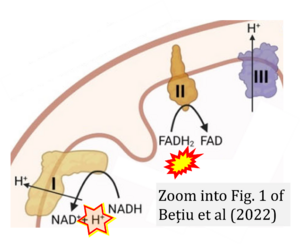Betiu 2022 Int J Mol Sci
| Bețiu AM, Noveanu L, Hâncu IM, Lascu A, Petrescu L, Maack C, Elmér E, Muntean DM (2022) Mitochondrial effects of common cardiovascular medications: the good, the bad and the mixed. Int J Mol Sci 23:13653. https://doi.org/10.3390/ijms232113653 |
Betiu AM, Noveanu L, Hancu IM, Lascu A, Petrescu L, Maack C, Elmer Eskil, Muntean DM (2022) Int J Mol Sci
Abstract: Mitochondria are central organelles in the homeostasis of the cardiovascular system via the integration of several physiological processes, such as ATP generation via oxidative phosphorylation, synthesis/exchange of metabolites, calcium sequestration, reactive oxygen species (ROS) production/buffering and control of cellular survival/death. Mitochondrial impairment has been widely recognized as a central pathomechanism of almost all cardiovascular diseases, rendering these organelles important therapeutic targets. Mitochondrial dysfunction has been reported to occur in the setting of drug-induced toxicity in several tissues and organs, including the heart. Members of the drug classes currently used in the therapeutics of cardiovascular pathologies have been reported to both support and undermine mitochondrial function. For the latter case, mitochondrial toxicity is the consequence of drug interference (direct or off-target effects) with mitochondrial respiration/energy conversion, DNA replication, ROS production and detoxification, cell death signaling and mitochondrial dynamics. The present narrative review aims to summarize the beneficial and deleterious mitochondrial effects of common cardiovascular medications as described in various experimental models and identify those for which evidence for both types of effects is available in the literature.
Correction: FADH2 and Complex II
- FADH2 is shown as the substrate feeding electrons into Complex II (CII). This is wrong and requires correction - for details see Gnaiger (2024).
- Gnaiger E (2024) Complex II ambiguities ― FADH2 in the electron transfer system. J Biol Chem 300:105470. https://doi.org/10.1016/j.jbc.2023.105470 - »Bioblast link«
Hydrogen ion ambiguities in the electron transfer system
Communicated by Gnaiger E (2023-10-08) last update 2023-11-10
- Electron (e-) transfer linked to hydrogen ion (hydron; H+) transfer is a fundamental concept in the field of bioenergetics, critical for understanding redox-coupled energy transformations.
- However, the current literature contains inconsistencies regarding H+ formation on the negative side of bioenergetic membranes, such as the matrix side of the mitochondrial inner membrane, when NADH is oxidized during oxidative phosphorylation (OXPHOS). Ambiguities arise when examining the oxidation of NADH by respiratory Complex I or succinate by Complex II.
- Oxidation of NADH or succinate involves a two-electron transfer of 2{H++e-} to FMN or FAD, respectively. Figures indicating a single electron e- transferred from NADH or succinate lack accuracy.
- The oxidized NAD+ is distinguished from NAD indicating nicotinamide adenine dinucleotide independent of oxidation state.
- NADH + H+ → NAD+ +2{H++e-} is the oxidation half-reaction in this H+-linked electron transfer represented as 2{H++e-} (Gnaiger 2023). Putative H+ formation shown as NADH → NAD+ + H+ conflicts with chemiosmotic coupling stoichiometries between H+ translocation across the coupling membrane and electron transfer to oxygen. Ensuring clarity in this complex field is imperative to tackle the apparent ambiguity crisis and prevent confusion, particularly in light of the increasing number of interdisciplinary publications on bioenergetics concerning diagnostic and clinical applications of OXPHOS analysis.
Labels:
Enzyme: Complex II;succinate dehydrogenase




